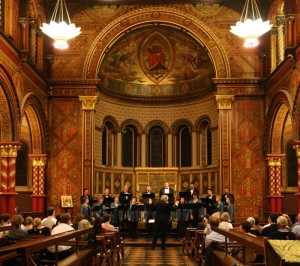 It is from Hermann Finck in 1566 that we learn much about sixteenth century choral sound and choral practices: “The treble should be sung with a delicate and sonorous tone, the bass, however, with a harder and heavier tone: the middle voices should move with uniformity and try to match themselves to the outer parts sweetly and harmoniously.”
It is from Hermann Finck in 1566 that we learn much about sixteenth century choral sound and choral practices: “The treble should be sung with a delicate and sonorous tone, the bass, however, with a harder and heavier tone: the middle voices should move with uniformity and try to match themselves to the outer parts sweetly and harmoniously.”
A constant dynamic level should be maintained throughout a composition “so that there is no discrepancy in sound between the beginning and the end: the tone should not be too soft or too loud, but rather, like a properly built organ, the ensemble should remain unaltered and constant … The higher a voice rises, the quieter and more gentle should be the tone; the lower it goes, the richer should be the sound, just as in an organ … When there is a tasteful point of imitation at the beginning of a work this is to be rendered with a more definite and distinct tone than is employed elsewhere, and the following parts, if they start with the same point as the first, should perform it in the same way. This should be observed by all the parts whenever a new point occurs.”
All these observations are supported by other sixteenth-century writers, from whom we also learn further details, all of which have contributed to the approach we take to our performances of music of this time. It is only in the late sixteenth century, and through the influences of the madrigal, that dynamic chiaroscuro becomes a component of choral performance.
Secondly, our approach to tuning is based on the ideals of pure intonation. Pure major thirds are considerably smaller than equal-tempered major thirds, which are really quite discordant. Pure minor thirds, on the other hand, are wider than the equal-tempered approximation. Semitones are major (diatonic) or minor (chromatic), the former almost twice the size of the latter.
There is a further element of our performance of music of the High Renaissance that differs from what listeners may encounter elsewhere. This is our approach to musica ficta, based on the research of director, John O’Donnell, which deviates considerably from what has in our century been considered appropriate for music of this era. It is clear that composers of the period were no more bound by so-called rules of composition than composers of any other period, and the music is full of forbidden false fifths and false unisons and octaves. The latter are what we should generally call simultaneous false relations, traditionally regarded as an English phenomenon of the period of Tallis and Byrd. But according to early writers it was Gombert who was master of the false relation, and its use by him and his contemporaries exhibits much greater variety than is encountered in the typical English cadence.
